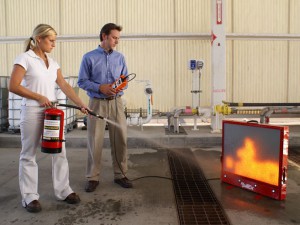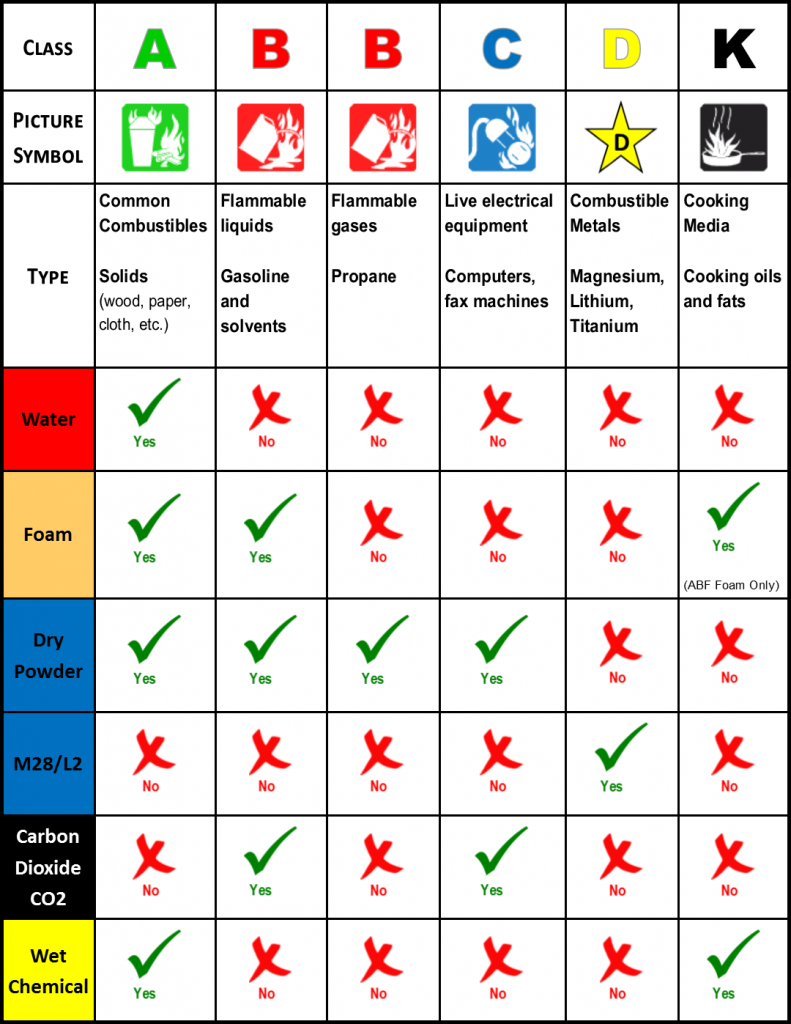-
April 13, 2016 by Total Fire and Safety

If your business has more than ten employees, they are going to need annual fire safety training. Some businesses rush to the least expensive program that will satisfy OSHA requirements, assuming that all training is the same; however, that’s simply not true. Fire safety training can vary in quality based on a number of factors, and many come with “hidden” fees that you may not be aware of. So what should you look for? Here are some important questions to ask before you book the training company.
1. What kind of course would you recommend? The course you need for your company should address the most probable emergencies that can occur at your facility. A training company worth its salt will tailor the course to your needs, surveying your business ahead of time to determine the most important content needed for your employees.
2. Who is teaching the course? Make sure the instructors are experienced professionals who know what real emergencies are like and how they occur. It’s even better if the instructor has experience with real-life emergencies. Nothing compares to the knowledge of a first responder who has faced countless fires and hazardous events. They can share personal stories, anecdotes and examples related to the training, which can make the class more interesting.
3. What will the course cover? Basic training courses cover how to use the fire extinguisher, but the most important thing employees should learn is WHEN to use the fire extinguisher. A good training course will focus on the importance of making fast and accurate, life-or-death decisions. Not only should your employees know how to fight fires, but also WHEN to fight the fire, and most importantly, when not to fight the fire. Evacuating and leaving it to the professionals is sometimes the best decision an employee can make.
4. Where will the training take place? Many fire safety trainings are performed outdoors, with a live burn in a pan that employees practice extinguishing. Although exciting, putting out a pan fire in a parking lot does not accurately simulate a realistic fire or emergency situation! Also, elements of the weather such as wind can affect the fire and unrealistically hamper the efforts of the employee trying to learn proper extinguishing techniques. It is much more effective to practice emergency procedures where they actually occur—inside the facility. With the help of digital technology, your employees can learn to extinguish the exact type of fire they would most likely face right at their worksite. This “on-the-spot” training also helps employees develop realistic evacuation plans and teach them to work as a team in an emergency situation.
5. Will there be extra costs involved with the equipment or the course materials? If the trainer is using “live burns”, or actual fires to practice extinguishing, you will need to have a burn permit and may incur any associated costs with setting up an outdoor space needed for the demonstration. If the training company uses your fire equipment for a live burn session, you will have to recharge them. You may not have budgeted for this unexpected, volatile cost, and it will vary based on how many turns each participant receives to extinguish the fire. The fire safety courses offered by Total Fire & Safety use high-tech, virtual simulators to practice extinguishing fires, which are versatile and allow more practice for each participant. These simulators feature virtual fire on a screen that responds realistically to the participant’s motions with the fire extinguisher. The indoor training gives each person multiple attempts with a full extinguisher every time until they feel confident with their firefighting skill. Compared to outdoor training, simulated training is more cost effective, accurate, completely green, and requires no messy clean-up or permit fees.
So before booking a company to perform fire safety training for your employees, ask these questions to make sure you receive your money’s worth for your employees and your business. No one can predict how an emergency will unfold, but the right training company can make sure your employees are not only prepared to fight a fire, but are adept at making quick decisions about whether or not it is safe to do so. For more information, contact the professionals at Total Fire & Safety at 630-960-5060.
Category: Fire Extinguishers, Fire Extinguishers, Fire Safety, Total Fire and Safety Tags: employee training, Fire Extinguisher, fire safety, fire safety training, fire training, fire training technology | Comments Off on Five Important Questions to Get Your Money’s Worth from Fire Safety Training
-
February 26, 2016 by Total Fire and Safety
 You may think you know the importance of first aid and fire safety, but the real impact of first aid and fire equipment training in the workplace is often overlooked. Whether your business is a high or low-risk environment, there are always risks that can lead to medical emergencies. You may think you know the importance of first aid and fire safety, but the real impact of first aid and fire equipment training in the workplace is often overlooked. Whether your business is a high or low-risk environment, there are always risks that can lead to medical emergencies.
1. Increasing profitability. A safer workplace means less missed workdays due to injuries. According to the National Safety Council, in 2012, nearly 5 million workers were injured at work, which costed employers a total of $198.2 billion.
2. Saving your employees time and money. It is proven that businesses and employees will save money if accidents are handled quickly and effectively. The National Safety Council attests that 25 percent of all emergency room visits can be avoided with basic first aid and CPR certification.
3. It really does save lives. If your employees don’t know how to handle injuries, the condition of the victim could worsen before the ambulance arrives, and cause further trauma and debilitation, not to mention medical costs and possibly, even death. Having a commercial first aid kit on the job sends a message to your employees that you value their health and well-being and are doing all you can to mitigate any injuries that occur on the job. It also shows that you never want your employees to be vulnerable to unattended injury.
4. It is required by law for many workplaces. The Occupational Safety and Health Administration requires businesses to provide first aid and CPR training to employees if there is no nearby clinic or hospital. Make sure you also have a commercial first aid kit available in your workplace. Obviously, if your business deals with risky materials or conditions, having a commercial first aid kit makes sense whether or not you are bound by law.
5. Teach your employees how to use emergency equipment. You spend money keeping your workplace up to code with commercial fire extinguishers and first aid kits, but these things don’t handle emergencies by themselves! Your employees need to know how to work fire extinguishers and use first aid supplies correctly. The investment need not be costly; a simple on-site class with the staff in attendance should suffice.
Total Fire & Safety can handle all your needs whether it be fire extinguishers, first aid kits, fire extinguisher training, or first aid training. For more information, visit our website or you can contact us at 630-960-5060.
Category: Fire Extinguishers, Fire Safety, First Aid Kits, Total Fire and Safety Tags: fire safety training, fire training, first aid, first aid kit, first aid training, training | Comments Off on Five Reasons Why Employees Should Have First Aid Training
-
January 15, 2016 by Total Fire and Safety
Not only are fire extinguishers an important part of our everyday safety, but they are a part of our history as well. Have you ever wondered how this device became the little red powerhouses that keep our home and workplaces safe? Here are the highlights of fire extinguisher development throughout history.
- 200 BC- Ctesibius of Alexandria fashions a hand pump designed to deliver water to fires. It replaced the cumbersome technique of passing buckets from hand-to-hand to transport water to fire.
- The Middle Ages– Devices called ‘squirts’ were developed which worked like bicycle p
 umps. These were used on the 1666 Great Fire of London. umps. These were used on the 1666 Great Fire of London.
- 1819- Captain George Manby invents the first version of the modern portable fire extinguisher. It consisted of a copper vessel which sprayed a potassium carbonate solution using compressed air.
- 1912– An extinguisher model using carbon tetrachloride is mass-produced. It was suitable for liquid and electrical fires and was popular in motor vehicles for decades. However, the ingredients in this extinguisher were highly toxic, and some deaths did result in its use, particularly in small spaces.
- Mid-twentieth century– The modern fire extinguisher emerges, followed by various models using different ingredients. They generally use some kind of pressurized vessel to store and discharge the extinguishing agent.
Fire extinguishers have come a long way and remain our best defense against fire. It is important that everyone understand how to operate a fire extinguisher and to have proper fire extinguisher inspections. Fire extinguishers are required in commercial buildings, and it is also important to be up to code with your fire prevention. If you have questions about your building’s fire extinguisher requirements or would like more information about fire extinguishers, contact Total Fire and Safety at 630-960-5060.
Category: Fire Extinguishers, Fire Extinguishers, Total Fire and Safety Tags: Extinguisher, Fire Extinguisher, fire extinguisher history, firefighter history, history | Comments Off on Who Invented Fire Extinguishers?
-
August 18, 2015 by Total Fire and Safety
 1. There are different types of extinguishers for different fires. Make sure the fire extinguisher types in your building are the right type for the kind of fire that may happen, depending on the materials present in your business. 1. There are different types of extinguishers for different fires. Make sure the fire extinguisher types in your building are the right type for the kind of fire that may happen, depending on the materials present in your business.
2. To use a fire extinguisher, remember PASS. This acronym will walk you through the steps of using a fire extinguisher:
– Pull the pin. Hold the extinguisher with the nozzle
pointing away from you, and release the locking
mechanism.
– Aim low. Point the extinguisher at the base of the fire.
– Squeeze the lever slowly and evenly.
– Sweep the nozzle from side-to-side.
3. Fire extinguishers must be inspected by a licensed fire protection company on a monthly basis. This is an NFPA requirement. Total Fire and Safety has a 12-point fire extinguisher check that thoroughly assesses each portable fire extinguisher unit.
4. Fire extinguishers should be installed near exits. This will allow you to stay safely near an exit when using the extinguisher. If you do use it, keep a clear path to the exit and face your back to that exit. Evacuating all personnel is always the priority if a fire breaks out, so make sure you and everyone with you is within safe distance of an exit before attempting to extinguish the fire.
5. Employee training services are available. Total Fire & Safety has comprehensive training courses on many safety topics and fire equipment, such as CPR, machine safeguarding, emergency preparedness, and many others. They offer OSHA and AHA compliance courses in these topics also.
For more information about fire extinguishers in businesses, you can contact Total Fire and Safety at 630-960-5060.
Category: Fire Extinguishers, Fire Extinguishers, Fire Safety, Total Fire and Safety Tags: business, employee training, Extinguisher, Fire Extinguisher, fire extinguishers, fire safety, fire safety tips, safety training | Comments Off on 5 Things Businesses Should Know About Fire Extinguishers
-
June 17, 2015 by Total Fire and Safety
All fires and fire extinguishers are not created equal. It is important, especially in a commercial setting, that a business has the right kind of fire extinguishers available and ready to go for the most probable fires. Fires are classified five ways (see chart below). While a restaurant may be most concerned with Type K fires, a manufacturing plant may be concerned with B or D.
According to the NFPA, the materials which ignite the most industrial fires are flammable liquids and gases, and electrical wire or insulation. These materials are common in industrial settings, so be sure to follow all fire safety recommendations, and know what kind of fire extinguishers are best to have on hand in the workplace.
Here is a chart that explains which type of fire extinguishers work for each type of fire. Of these fires, only one (type A) can be extinguished with water. The rest require special ingredients that cut off oxygen in different ways, therefore, it’s important to have the right kind of extinguisher on hand.

Once you have the correct extinguisher in place, it’s also important to make sure that you have regularly scheduled fire extinguisher inspections and that your employees have correct fire extinguisher training. Total Fire and Safety offers fire extinguishers for every type of fire. If you have any questions about the type of extinguisher you should have onsite, or current extinguisher maintenance issues, please feel free to contact us at 630.960.5060
Category: Fire Extinguishers Tags: Fire Extinguisher, fireextinguisher, Fireextinguishertraining, firesafetytraining | Comments Off on Do You Know What Type of Fire Extinguisher Your Business Needs?
-
March 12, 2013 by admin
Using state of the art technology, our Total Fire & Safety service team uses custom built reports that include voice data, photos, and apply all AHJ and state applicable codes. This ensures that your
company’s fire protection equipment has been tested properly.
Our service technicians go through extensive training in order to receive their state certifications. We hold regular in house safety meetings and continuous education programs to ensure that our technicians are always up to date on all the newest codes and standards.
In fact, our management team does regular onsite audits to ensure the job has been done correctly.
12-Point Portable Fire Extinguisher Service Check:
- Visual Examination: performed on the entire unit, carefully inspecting for dents, rust, corrosion, pitting or other shell damage
- Test/Maintenance History: reviewed to determine the need for required internal maintenance or hydrostatic testing
- Pressure Gauge: checked to ensure that the unit is fully pressurized
- Weight: the extinguisher is checked to ensure the correct amount of extinguishing agent is in cylinder
- Discharge Hose: removed to inspect for signs of blockage or damage
- Locking Pin: removed to ensure that the pin is easily removed in the event of an actual fire emergency
- Handle/Lever: checked for smooth discharge operation
- Clean Extinguisher: using a degreasing solution
- Inspection Certification: documented by attaching a safety flag and service tag indicating the work performed
- Extinguisher: returned to the proper location
- Mounting Bracket: checked to ensure extinguisher is installed securely on correct mounting hook or bracket
- Hazard Application: reviewed to make sure that the fire extinguisher is the correct type for a potential fire hazard
Category: Fire Extinguishers, Fire Safety Tags: businesssafety, equipment, Extinguisher, fire, Fire Extinguisher, fireextinguisher, safety, technology, training | Comments (1)
|

|
|
|
|
|
|
 Facebook
Facebook
 Instagram
Instagram
 LinkedIn
LinkedIn





